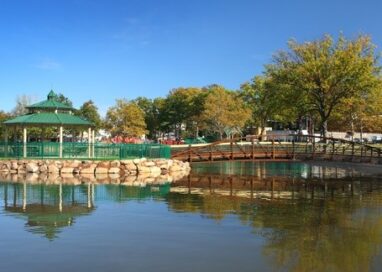Bogota
The Borough of Bogota was formed on November 14, 1894, from portions of Ridgefield Township, based on the results of a referendum held that day. It was a result of the “Boroughitis” phenomenon then sweeping through Bergen County, in which 26 boroughs were formed in the county in 1894 alone.
Prior to the founding of the Borough of Bogota, the area was inhabited by members of the Lenape Tribe until the early 1600s when Dutch settlers arrived. The Dutch were replaced by the British in 1664, Following the Civil War, Bogota evolved from a farming area to a suburban and industrial one.
Following his move to Bogota in 1893, Frederick W. Cane led the successful effort for a special election regarding the incorporation of the Borough. The population was about 250 at the time, although only 57 votes were cast. Cane was elected the first mayor in 1895. It can be considered the year when farming began to decline and Bogota started to become a small suburban town with an important industrial element.
In 1898, the electric trolley shattered the then semi-rural nature of Bogota. Most of the new residents were members of the business and professional classes as opposed to the farmers who were there first. There was also a small, local retail and service population that provided such things as coal and lumber, and trades such as carpentry.
Economically the Borough was also developing. William N. Smith was busy with his paper mills, but still had time to form the Bogota National Bank on East Fort Lee Road close to the railroad tracks and potential customers coming off the trains. Another institution, the Bogota Savings Bank, was started as the Bogota Savings and Loan in 1893. Judge Peter Bogert, part of the Bogert farming family, was the first president. William N. Smith became president a few years later; he was part of the “commuter” faction that helped form Bogota in opposition to Peter Bogert.
By 1939, Bogota was expanding rapidly and had at least ten times the population of 1912. Main Street was a busy commercial street in addition to the shops, banks, bowling alleys, etc. on West and East Fort Lee Road. Big changes in the business district in 1939 effectively ended Fort Lee Road’s role as the most important business street in town. Major construction projects, connected with each other, forever changed the town. The construction of the Main Street overpass, the construction of the Grade Level Crossing over the West Shore railroad tracks, and the extension of Main Street into Hackensack were the last major changes in Bogota’s infrastructure until the opening of Interstate 80 in the 1960s.
The 1960s also saw another change in the character of Bogota: most of the paper mills closed. A great many had been involved in producing materials needed to win World War II. New Jersey was a great manufacturing area then, and Bogota had some impressive capability in its paper mills and the Brewster Construction Company. The last paper mill, the Continental mill, closed in 1970. Almost all of our major industries left town for one reason or another. As a result, families turned to service-oriented occupations.
June 1992 saw the closing of the Dewey School due to declining enrollments. Plans to replace the Steen and Bixby Schools were made but they were defeated by the voters in 1993.
The Borough celebrated its 125th Anniversary in 2019 with the issuance of a fourth anniversary journal. These volumes can be consulted for more information about the Borough’s past.
-
Economy - 79%
79%
-
Safety - 63%
63%
-
Amenities - 67%
67%
-
Cleanliness - 64%
64%
Summary
Bogota, New Jersey is a small borough located in Bergen County, with a population of around 8,000 people. This vibrant and dynamic community is known for its diverse population, strong economy, and convenient location.
One of the biggest draws of Bogota is its diverse population. The borough is home to a mix of racial and ethnic groups, which contributes to its vibrant and exciting culture. This diversity is reflected in the borough’s many cultural events and activities, which provide residents with plenty of opportunities to learn and explore.
In terms of its economy, Bogota is home to a number of major corporate headquarters, as well as a thriving small business community. This provides a range of employment opportunities for residents and helps to keep the local economy strong.
Another major benefit of living in Bogota is its convenient location. The borough is just a short drive from New York City, making it an attractive option for commuters. It’s also well-served by public transportation, with several train stations and bus routes providing easy access to the surrounding area.
In terms of recreational activities, Bogota has a lot to offer. The borough is home to a number of parks and green spaces, including Bogota Memorial Park and the Overpeck County Park. There are also plenty of options for shopping, dining, and entertainment, with a mix of local businesses and national chains.
In terms of age, Bogota has a relatively balanced population, with a slightly higher percentage of residents aged 25-44 compared to other age groups. The median age of residents is around 35 years old.
Bogota is also a relatively affluent borough, with a median household income of around $90,000. This is higher than the state and national averages, which stand at around $80,000 and $60,000, respectively.
Overall, Bogota is a vibrant and dynamic borough with a lot to offer. Whether you’re looking to raise a family, start a business, or simply enjoy all that the borough has to offer, Bogota is an excellent place to call home.
User Review
( votes)Pros
-
Diverse population: Bogota is a diverse and multicultural borough, with a population that reflects the rich cultural and racial diversity of the region. This makes it an exciting and vibrant place to live, with a wide range of cultural events and activities to enjoy.
- Strong economy: Bogota is home to a number of major corporate headquarters, as well as a thriving small business community. The borough’s strong economy provides a range of employment opportunities for residents.
- Convenient location: Bogota is located just a short drive from New York City, making it an attractive option for commuters. The borough is also well-served by public transportation, with several train stations and bus routes providing easy access to the surrounding area.
Cons
- High cost of living: Like many towns in the region, Bogota has a high cost of living, with housing prices and other living expenses being higher than the national average. This may be a concern for some potential residents.
-
Limited green space: While Bogota has a number of parks and green spaces, it’s not as abundant in these types of amenities as some other towns in the region. This may be a concern for those who value access to outdoor recreation.
- Traffic: Bogota is located in the heart of the New York City metropolitan area, which can lead to heavy traffic and congestion on the roads. This may be a concern for those who are looking for a more laid-back lifestyle.



